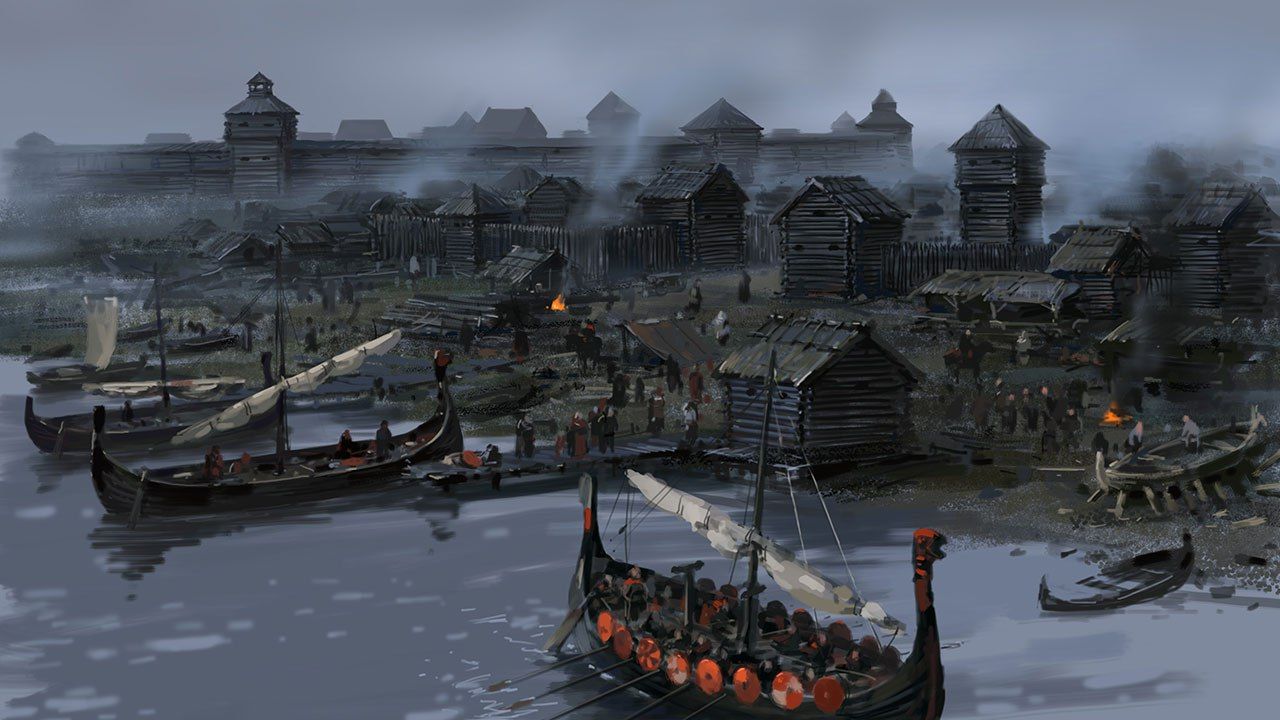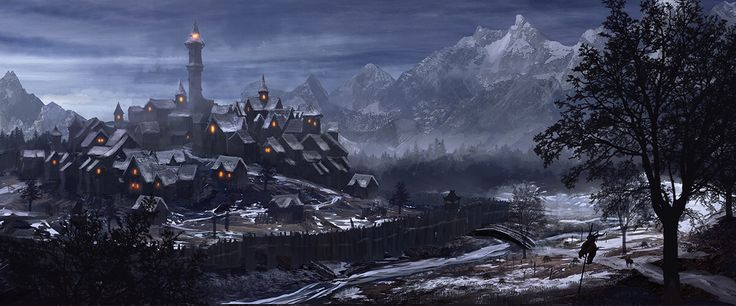Thiardan
History
The Thiardans of Thiarfell trace their origins to the dawn of the Second Age, possibly making them one of the very first cultures to form. Nestled in the peaceful yet wild highlands of Thiarfell, known as the Restful Heights, their homeland is a landscape of gentle hills and towering mountains, rich in resources but fraught with natural dangers. Their way of life is deeply connected to the land, and they mine their riches with great care, always mindful of maintaining balance with the earth. Descended from the witches' blood of the Wealch, the Thiardans had strong ties to ancient magic. Their communities were born out of druidic circles, where sacred runic rituals were passed down through generations, preserving their mystical heritage. Not only were they influenced by druids, but also by hags and crones who wielded powerful witchcraft, further deepening their mastery of both runic magic and witchcraft traditions.
During their rise, the Thiardans faced their first and greatest conflict against the Titans, who had dominion over Thiarfell. In a legendary struggle for supremacy, the Thiardans managed to banish these colossal beings to the depths of the Whispering Sea, securing their homeland. However, despite this early battle, the Thiardans remained a people more inclined to peace. They rarely engaged in further conflicts and never developed a warrior culture, despite their imposing appearance. Their tall, broad, and resilient forms give the impression of giant blood, leading some to believe they are built for war. Yet, their strength and size serve more as a natural gift rather than a mark of conquest.
By the end of the Second Age, the Wealch influence on the Thiardans had waned, and with it, the potency of the witches’ blood that once defined them. Their curiosity about other cultures led them to stray from their magical roots, and Thiarfell became the subject of many conquests. The Franks, the Gealics and the Gothics, all had an important influence on the terrirories and culture of Thiarfell through war or peace. Much of their heritage in magic was lost during these turbulent times. However, a resurgence of runic magic in the culture has rekindled a connection to their ancient legacy, allowing the Thiardans to rediscover some of the mystical traditions they had once forgotten. In the Third Age, Thiarfell has remained mostly quiet, with only a few wars waged over the millennia, all approved by the remaining druid circles. These druidic councils continued to hold the power to guide the powerful houses, deciding which among them will lead in times of conflict. The land of Thiarfell, with its towering people and vast potential, has become a sleeping giant in the west, nestled in the Restful Heights, content in its isolation yet still capable of great strength should the need arise.
After the Scourge and the dawn of the Fourth Age, the Thiardans experienced a cultural renewal, reclaiming many of their lost traditions, particularly those involving runic magic. The barons who ruled the hillforts of Thiarfell sought alliances with their neighbors, forming large, cooperative nations based on mutual interests and survival in a new age. In the wake of the devastating Witch Plague, many druid circles were reformed, now including non-magical natives who had long been excluded from these mystical communities. Wildists, who revere the primal forces of nature, and Lycanists, those attuned to shapeshifting and animalistic powers, became integral to the culture, reflecting a shift in the spiritual fabric of Thiarfell. This new era also saw the integration of the Mediaries’ ways, blending the ancient customs of the Wealch with the more modern practices of the Gothic peoples, creating a unique fusion of old and new beliefs that now defines the Thiardan identity.
Traits & Personnality
The average Thiardan possesses a striking physical presence, standing taller than most other cultures in Valklora, with a naturally robust and resilient physique shaped by generations in the rugged highlands of Thiarfell. Their hair is predominantly brown, though the original color has been lost to history, and they tend to gray earlier than most. Occasionally, black hair emerges among them, a trait inherited from the influence of the Franks. Their eyes are commonly shades of brown, ranging from deep and dark to lighter hues or shades of green, another subtle marker of Frank Dominion. Thiardans carry themselves with a quiet strength, their physical endurance matched by a stoic but welcoming demeanor that reflects both their challenging environment and the enduring traditions of their people.
Thiardans are renowned for their enhanced curiosity and an unshakable belief in the inherent goodness of people, which shapes their warm and trusting nature. They are welcoming to a fault, often viewed as naive because they trust easily, a reflection of their own deep loyalty to their word. Their values are steeped in pacifism, with violence considered only as a last resort when all other options have failed. This openness extends beyond their culture and family; their hospitality is legendary. A stranger knocking on a door at night, seeking shelter, can always expect food, warmth, and a place to rest, for the Thiardans believe in extending kindness to all who are in need.
Realms & Nobility
The realms born from the Thiardan culture have developed a unique structure of governance deeply rooted in their values and traditions. Barons, the stewards of these realms, wield authority only over what their people can directly occupy and cultivate, such as towns, villages, and cultivated lands. Wild fields, dense forests, and untamed mountains are considered beyond mortal dominion, sacred spaces that no Baron may claim as their own. These realms typically take the form of city states, bound together in alliances forged through trust and mutual need rather than conquest. Such alliances are often created peacefully, reflecting the Thiardans' pacifist ideals. Within these realms, each Baron's influence is tied to their ability to garner trust and inspire a loyal following rather than by force or hereditary power.
In times of war or dire need, the Barons unite to elect a Cælan Baron, a temporary sovereign who acts as the realm’s leader until peace is restored. This position is not hereditary and dissolves once the crisis has passed, ensuring that power remains a shared responsibility. Similarly, succession among the Barons themselves does not follow a direct lineage. Instead, when a Baron passes or steps down, a council of elders, reminiscent of the ancient druidic circles, convenes to deliberate and elect the next ruler. This system prioritizes wisdom, character, and the trust of the community, maintaining the Thiardan ideals of cooperation and shared stewardship over their lands and people.
In Thiardan realms, nobility is a dynamic blend of tradition, service, and influence, reflecting the culture's deep respect for wisdom and communal bonds. Barons, past and present, are considered part of the nobility, as their experience and counsel remain invaluable to the realm even after their rule ends. The families of Barons also share this noble status, carrying the legacy of their leadership. Alongside them stand the ancient houses. Lineages with deep roots in the land whose nobility is preserved even without holding a current barony. The aristocrates in thiarfell are by standard those with knowledge as leverage. Comprising of influential members of guilds, druid circles, and other organizations that shape the land and its people. These figures wield authority not through wealth, which holds little sway in Thiardan values, but through their contributions to the well-being and governance of the realm and their experience. In Thiardan realms, slaves are common, although they are treated with upmost respect and still deemed living beings and not tools simply replaced when broken.
Traditions
Thiardan traditions are rich with community spirit and a deep sense of connection, both to each other and to the rhythms of nature. Sharing ale, mostly in the form of beer is more than just a social custom, it is an integral part of their daily life, a symbol of friendship and hospitality. Thiardans believe that no gathering, whether among family, friends, or even strangers, is complete without raising a tankard together. Every full moon provides them with a reason to celebrate, marking a time to honor the bond between them and the nature under the moon’s glow. On some occasions where an important passing is notable, it is custom to wait a full moon. This ceremony is then called the Moonlit Farewell. It is, by celebration, helping the deceased to leave being grudge of flesh and soul. Like every other cultures, their most cherished holidays are during the equinoxes. However, they celebrate even more the Kynmæl's eve. If tales are true, a man named Kynmæl the white risked everything to mend the wound between the Titans and the thiardan of the second age. It is a sacred day of reconciliation where one must make peace with himself and his enemies by washing a bloodied blade together.
While sharing ale is a cornerstone of their traditions, the Thiardans’ celebrations are not solely focused on revelry. During the equinoxes, when druids, shamans, or wildists are present, these sacred occasions also serve as opportunities for cleansing rituals. These rituals are believed to purify, bless individuals or entire communities, and even break lingering curses, strengthening the bond between the Thiardans and the natural forces they revere. Another unique tradition is their blooming ceremony, marking the passage into adulthood. During this rite, individuals wishing to undergo the ritual cover themselves from head to toe with runes, believed to channel the blessings of the Aspects. They then seek out a willing partner to share their first night as an adult, a union thought to bring immense luck. If more than one volunteer steps forward, it can lead to a contest of skill, wit, or charm, with the bloomed having a chance to choose the contestant their choosing. The blooming is seen not just as a personal milestone, but as a celebration of a love in its wildest shape, purely physical and yet innocent.
Thiardan settlements, crafted predominantly from wood, are often intricately designed, showcasing the skill and artistry of their builders. While modest in size, these dwellings are anything but simple, often adorned with carved motifs of runes, animals, or scenes of nature that reflect the household’s values or aspirations. The heart of their communities lies in their hillfort cities, fortified with strong palisades that encircle the town and provide a sense of security amidst the wilds of Thiarfell. Inside these walls, life thrives around bustling marketplaces, communal gathering spaces where billboards are held. Commoners and adventurers alike can find work or tasks posted by those in need. Given the varying literacy levels among the Thiardans, these billboards are supplemented by town screamers, individuals tasked with announcing the latest news, opportunities, or proclamations to the populace, ensuring no one is left uninformed. This blend of artistry, practicality, and inclusivity makes Thiardan settlements welcoming hubs of culture and community.
Learned
- Domestic Wild (Start with a level 3 pet)
- Runic Warrior (Runic magic, can use magic infused component to cast ritual runic spells. Quicker version of runic spells are easier for runic warrior cast.)
- Simple Lifestyle (Rationing only impact exhaustion once you are starved)
- Savage Hunter (+1 throwables, can trade rest for à mind check+wisdom of hunting)
Inate
- Resilient (+5 hp)
- Barbarian (Take heat when damage is taken below 3, taking damage gives back stamina)
- One Eye Sleeper (Can sleep and rest and being on guard at the same)
- Thick Blood (Bleeding damage is reduced by 2)


